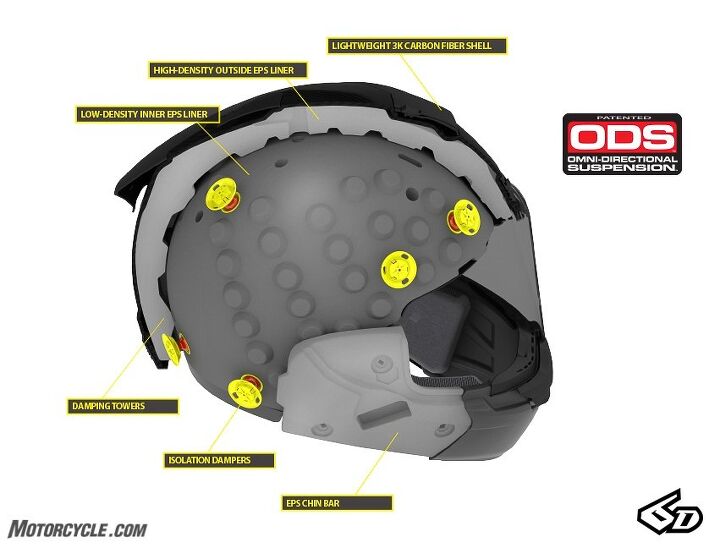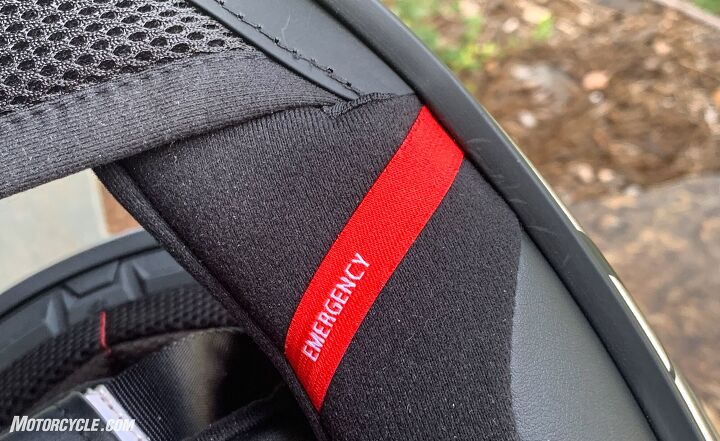| Aesthetics | 9.0/10 |
| Protection | 10.0/10 |
| Value | 8.25/10 |
| Comfort/Fit | 8.75/10 |
| Quality/Design | 9.5/10 |
| Weight | 9.0/10 |
| Options/Selection | 9.0/10 |
| Innovation | 10.0/10 |
| Weather Suitability | 9.5/10 |
| Desirable/Cool Factor | 09./10 |
| Overall Score | 92/100 |
My experience with the 6D ATS-1R started at WSBK weekend at Laguna Seca where I bumped into Bob Weber, who I worked with 20 years ago at Petersen Publishing. Since then he’s gone on to become one of the cofounders and the CEO of 6D Helmets. Bob asked me if I’d seen the latest version to the ATS-1, and I sheepishly admitted that I didn’t know it had been updated. I knew that Tom Roderick had really liked the original 6D ATS-1 back in 2016 when he tested it, but that was all I knew.
MO Tested: 6D ATS-1 Helmet Review
Well, in the time since Tom’s review, 6D has made some changes in its unique Omni-Directional Suspension (ODS) helmet design. In fact, the company’s name comes from “the engineering term 6 Degrees of Freedom, which refers to the ability to move 3-dimensionally in space about the Cartesian coordinate system of X, Y and Z, including rotation about each axis.” Essentially, the ODS is a suspension that separates two different layers of expanded polystyrene (EPS) inside the helmet. Separating these two layers of EPS are isolation dampers that allow the inner liner to float and rotate in any direction within the helmet, and in the case of glancing impacts, absorb angular accelerations that can cause rotational brain injuries. Also, by constructing the inner liner from a softer EPS, 6D claims its helmets do a better job of absorbing low-threshold impacts that would typically be transmitted through the stiffer foam of traditional helmets.

The cutaway shows how different the ATS-1R is from traditional helmets. The low-density liner that protects against low-impact forces floats inside the high-density EPS that protects against high-impact forces. These are allowed to rotate relative to each other during an impact while still maintaining the feel of a traditional helmet thanks to the isolation dampers.
For the ATS-1R, the ODS was further refined. Where the original street version utilized 29 elastomeric isolation dampers, the ATS-1R has reduced the number to 10. This represents significant weight savings. In fact, 6D claims a 200-gram weight reduction from the previous models, putting it in a similar weight range to the Shoei RF-1200 and X-14 or the Arai Corsair-X and Signet-X. On my home scale, the ATS-1R weighed in at 1638 grams (lighter than 6D claims), and my Corsair-X tipped the scale at 1710 grams (heavier than 6D claims).
Due to the helmet’s unique construction, the outer shell is larger than comparably-sized helmets. For example, the Large ATS-1R tested here is larger in exterior dimensions than either my XL RF-1200 or XL Corsair-X – but not significantly, though.

The baseplate system holds the visor snuggly closed and offers a variety of cracked open options. Swapping visors is extremely easy.
The cutaway photo illustrates why this is the case. The carbon fiber shell has a high-density outer EPS liner bonded to it. There is an inherent gap between the shells which are held in place by the isolation dampers that connect the low-density inner liner to the outer components. One of the positive side-effects of this construction is the ATS-1R vents better than any helmet I’ve ever used. The natural gap between the shells allows more space for air to move. Four adjustable intake ports direct the cool air through 15 internal transport ports before flowing out of five exhausts. A removable cover at the rear neck roll assists in this hot air egress. Really, quite impressive on scorching SoCal August days.
When I was having the construction and the effects that it has on the venting explained to me, I was fairly certain that the ATS-1R was going to be a noisy helmet with all that atmosphere moving through it. However, I couldn’t have been more wrong. The ATS-1R is actually one of the quietest helmets I have ever worn. Putting the rear neck cuff back in place makes it even quieter, but I’ll keep it out for the tail of summer heat. If I wanted even more airflow, I could remove the chin curtain, but I prefer to keep it in for its noise-damping effect.

With the neck cuff removed, you can see the unique shape of the EPS liner. The space between the EPS towers shows how much room there is for flowing air on hot days.
One of the features that aids in the helmet’s quietness is the close-fitting shield. In the update to the 1R, the baseplates were modified, as was the shield-to-shell sealing. The result is no annoying drafts or whistles. Also, switching to a tinted shield (or back) is extremely easy and didn’t require a YouTube search for a tutorial.
Close readers may have noticed the different sizes of helmets listed above, and this is one of the oddities of my experience with the ATS-1R. In almost every helmet I’ve owned, I have worn an XL helmet over my long/intermediate oval noggin. In the case of the 6D, an XL was too loose on my head, and I ended up using an L. The fit is approaching what I call a race fit, in that it is super snug on my head. Typically, that means I’m destined for hot spots front and rear, but not so with the ATS-1R. When I take off the helmet after an extended ride, I do have a red spot on my forehead, but that has never translated to an uncomfortable fit – just an extremely snug one. So, when buying an ATS-1R, I recommend actually trying it on to make sure it fits correctly.

Like most high-end helmets, the 6D ATS-1R comes with quick removal straps for the chin pads to allow for safer helmet removal after an accident.
In my time with the 6D ATS-1R, I’ve found it to be a comfortable, though snug, fit that I’ve been happy to wear on longer rides of more than an hour. (I haven’t had a chance to tour in it yet.) The venting is stellar – as is the quietness. It ships with a nicely appointed carrying case and a Pinlock visor. The ATS-1R’s price of $695 for solid colors and $745 for graphics puts it in the premium helmet category. While 6D may not have the name recognition (yet) that manufacturers, like AGV, Arai, and Shoei do, the build quality and premium additions put it in the premium range as far as features are concerned. If you’re looking for a helmet that is pushing head protection technology in new, important directions, go test a 6D ATS-1R for yourself. You may become a convert.
Shop for the 6D ATS-1R Helmet here
We are committed to finding, researching, and recommending the best products. We earn commissions from purchases you make using the retail links in our product reviews and other articles. Learn more about how this works.
The post MO Tested: 6D ATS-1R Helmet Review appeared first on Motorcycle.com.
【Top 10 Malaysia & Singapore Most Beautiful Girls】Have you follow?
